
The 10 Best Mailchimp Alternatives That Won’t Break Your Budget in 2025
Remember when Mailchimp was the obvious choice for email marketing? Those days are over.
I’ve been helping businesses with their email marketing for years, and lately, I’m having the same conversation over and over: “Mailchimp just got too expensive” or “I can’t figure out how to set up the automation I need.”
Sound familiar? You’re not alone. Over 13 million businesses still use Mailchimp, but a growing number are jumping ship. I keep seeing more and more businesses ditch Mailchimp once they realize there are better options out there.
Here’s the thing – what started as an affordable solution for small businesses has turned into a platform that often prices out the very people who made it popular. Meanwhile, your needs have probably gotten more complex. You want better automation tools, clearer reporting, and easier connections to other apps. Mailchimp just hasn’t kept up.
The good news? The email marketing world has exploded with options that actually make sense. Whether you need emails that send based on what people do on your website, want to see which emails actually make you money, or just need something that won’t double your bill when you hit 2,000 subscribers, there are some solid alternatives worth considering.
Let’s be honest – switching email platforms feels like a huge pain. But sticking with something that’s costing too much and holding you back is worse. These alternatives address the core issues that make people want to leave Mailchimp in the first place.
Table of Contents
-
TL;DR: Quick Comparison Overview
-
Criteria Breakdown Summary
-
ActiveCampaign – For When You Want All the Bells and Whistles
-
Brevo (formerly Sendinblue) – The Smart Money Choice
-
Klaviyo – Ecommerce’s Best Friend (Just Watch Your Wallet)
-
MailerLite – Simple But Powerful
-
Constant Contact – Old School But Reliable
-
GetResponse – The Swiss Army Knife
-
Omnisend – Built for Online Stores
-
Moosend – Fancy Features, Budget Price
-
HubSpot – Free CRM That Actually Works
-
Kit (formerly ConvertKit) – Made for Content Creators
-
Notable Mentions
-
Frequently Asked Questions
-
Final Thoughts
TL;DR: Quick Comparison Overview
Time is money, and I know you want the highlights before diving deep. Here’s what actually matters when looking at Mailchimp alternatives.
ActiveCampaign has the most advanced automation I’ve seen, and your emails actually get delivered (94.2% success rate). Starts at $15/month, but it’s worth it if you need complex customer journeys.
Brevo is the smart money choice – you pay for emails sent, not contacts stored. Finally, a pricing model that makes sense! Starts at $8/month and includes unlimited contacts even on their free plan.
Klaviyo dominates if you run an online store. Their predictive analytics and revenue tracking are incredible, starting at $20/month. Just watch those costs as you grow.
MailerLite is perfect if you want something that just works without the learning curve. Generous free plan and you can create professional emails in minutes, not hours.
Constant Contact feels like it’s stuck in 2015, but their support team actually picks up the phone. Starts at $12/month and includes event management tools.
GetResponse tries to do everything – email, webinars, landing pages, sales funnels. It’s pretty good at most things, starting at $15/month.
Omnisend is built specifically for ecommerce with multi-channel campaigns that coordinate email, SMS, and push notifications. Starts at $16/month, but the deliverability could be better.
Moosend gives you fancy automation features without the fancy price tag. Starting at just $7/month, your accountant will thank you.
HubSpot offers a free CRM that’s actually useful (rare!), but their paid plans will make your wallet cry. Marketing Hub starts at $15/month per seat.
Kit is made for content creators who want to monetize their audience. Unique tools for selling digital products and building communities, starting at $25/month.
Comparison Table
|
Platform |
Starting Price |
Best For |
Deliverability |
Free Plan |
Key Strength |
|---|---|---|---|---|---|
|
ActiveCampaign |
$15/month |
Advanced Automation |
94.2% |
No |
Sophisticated workflows |
|
Brevo |
$8/month |
Multi-channel Marketing |
74.7% |
Yes (Unlimited contacts) |
Value pricing |
|
Klaviyo |
$20/month |
Ecommerce |
89.2% |
Yes (250 contacts) |
Revenue attribution |
|
MailerLite |
$9/month |
Simplicity |
89.1% |
Yes (1,000 contacts) |
Ease of use |
|
Constant Contact |
$12/month |
Small Business |
91.7% |
No |
Customer support |
|
GetResponse |
$15/month |
All-in-one |
90.3% |
Yes (500 contacts) |
Webinar integration |
|
Omnisend |
$16/month |
Ecommerce Automation |
78.5% |
Yes (250 contacts) |
Multi-channel campaigns |
|
Moosend |
$7/month |
Budget Automation |
90.2% |
Yes (1,000 contacts) |
Affordable features |
|
HubSpot |
$15/month |
CRM Integration |
88.9% |
Yes (1,000 contacts) |
Complete platform |
|
Kit |
$25/month |
Creator Monetization |
87.8% |
Yes (1,000 subscribers) |
Revenue tools |
Criteria Breakdown Summary
Look, I could bore you with a ton of technical specs, but here’s what actually matters when you’re picking an email platform.
Does it fit your budget as you grow? This is huge. Many platforms look cheap until your list hits a few thousand subscribers, then BAM – your bill triples. I’ve seen businesses get shocked by sudden price jumps that force them to scramble for alternatives. The smart money is on platforms with predictable pricing that won’t punish you for success.
Can it do what you need without a computer science degree? You want automation that actually works, segmentation that makes sense, A/B testing that’s not a pain to set up, and connections to the other tools you use. If you’re spending more time fighting with your email platform than creating content, you’ve got the wrong tool.
Do your emails actually reach people? This seems obvious, but you’d be surprised how many “cheap” platforms have terrible deliverability. Your beautiful emails don’t matter if they’re sitting in spam folders. I prioritize platforms that consistently get 90%+ of emails into inboxes.
Can your team actually use it? The most powerful platform in the world is useless if nobody on your team can figure it out. Some tools require weeks of training; others you can master in an afternoon. Know your team’s skill level and pick accordingly.
Does it play nice with your other tools? Your email platform needs to connect with your website, CRM, ecommerce store, and whatever else you’re using. Native integrations usually work better than piecing things together with third-party tools like Zapier.
ActiveCampaign – For When You Want All the Bells and Whistles
The Automation Powerhouse
ActiveCampaign has earned its reputation as the go-to choice when you need email marketing that can handle complex stuff. While other platforms offer basic drip campaigns, ActiveCampaign lets you build sophisticated workflows that respond to what people actually do – visit certain pages, make purchases, or ignore your emails entirely.
The visual automation builder is honestly pretty impressive. You can create customer journeys with dozens of branches and conditions that would be impossible on simpler platforms. This isn’t just about sending follow-up emails – you’re building comprehensive marketing experiences that adapt to each person.
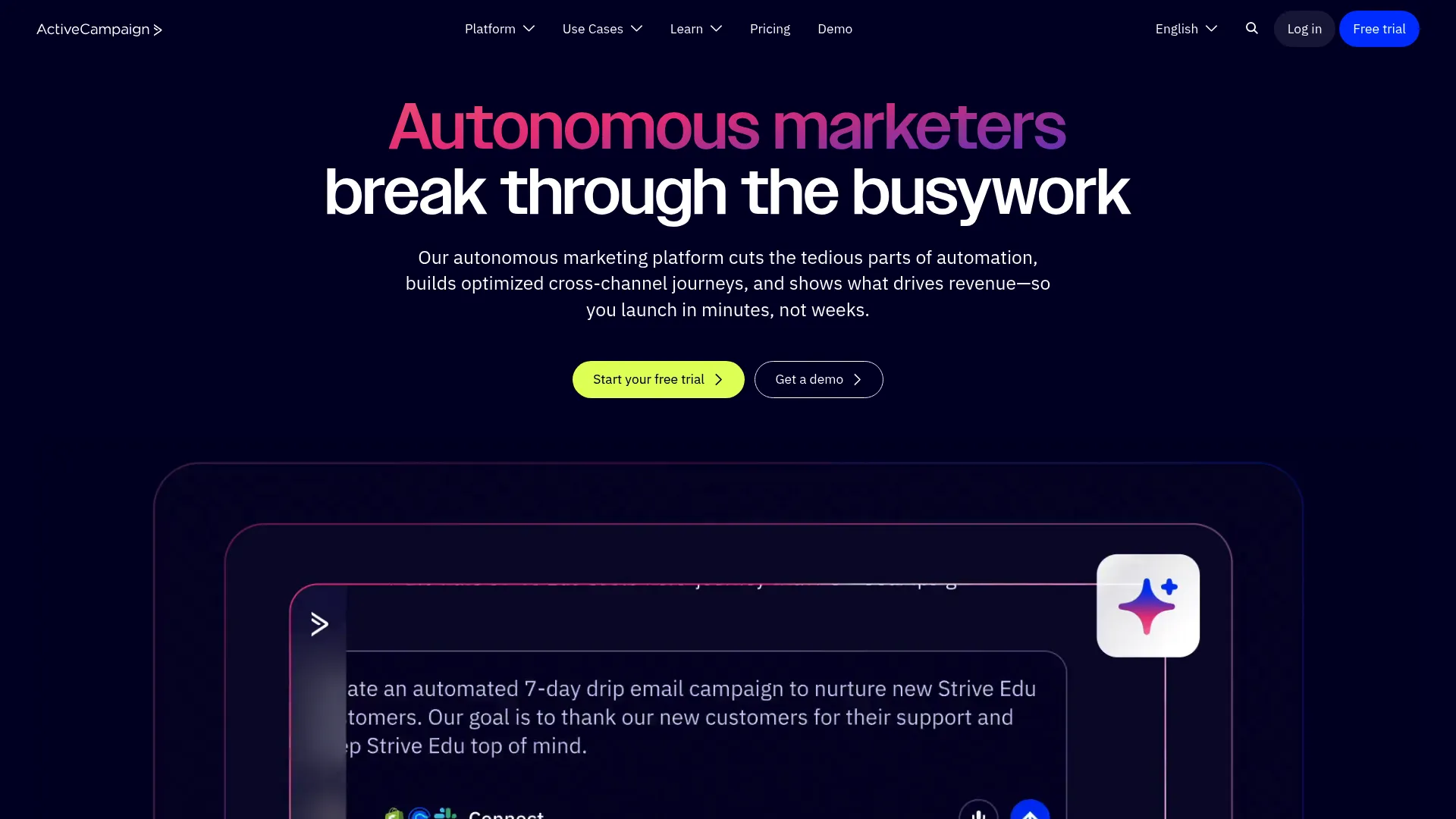
What You Get
Beyond email marketing, ActiveCampaign includes a built-in CRM that actually talks to your marketing campaigns. You can trigger emails based on where someone is in your sales process, and their lead scoring automatically identifies your hottest prospects. The segmentation options are pretty much endless.
You also get SMS marketing, website messaging, and landing page creation. The machine learning features continuously optimize when your emails get sent and what content performs best. With 950+ integrations, it connects with basically any tool you’re already using.
What’s Great
The automation capabilities are genuinely impressive – I’ve built workflows with dozens of conditional branches that would be impossible on simpler platforms. Your emails actually get delivered (94.2% success rate), and their support team knows what they’re talking about instead of just reading from scripts.
The CRM integration means your marketing and sales teams can finally stop working in silos. You can track someone’s complete journey from first website visit through becoming a customer, which makes it way easier to see what’s actually working.
What’s Not So Great
ActiveCampaign has a steep learning curve. If you’re used to simple email tools, this might feel overwhelming at first. There’s no free plan, which makes it harder for bootstrapped startups to get started.
The pricing can get expensive fast as your contact list grows, especially if you want the advanced features like predictive sending and detailed attribution reports. Small businesses might find it hard to justify the cost early on.
The Real Deal
Pricing gets pricey but delivers value – You’ll pay more than basic alternatives, but the automation sophistication justifies it
Features are industry-leading – Unmatched automation and CRM capabilities
Emails actually get delivered – Consistently high inbox placement rates
Takes time to master – Powerful but requires learning investment
Connects to everything – Extensive integration library
What Users Actually Say
People consistently praise ActiveCampaign’s automation power and deliverability. Users love that they can create complex workflows that would require multiple tools elsewhere. The visual automation builder gets particular praise for making advanced features accessible.
The main complaint? The initial complexity can feel overwhelming. Some users wish there was a simpler mode for basic campaigns, since the extensive features sometimes feel like overkill for straightforward newsletters.
Source: Venture Harbour ActiveCampaign Review
Pricing
ActiveCampaign starts at $15/month for up to 1,000 contacts with full email marketing and automation. The Plus plan ($49/month) adds CRM functionality and better reporting. Professional ($149/month) includes machine learning optimization and attribution tracking.
Get started with ActiveCampaign
Brevo (formerly Sendinblue) – The Smart Money Choice
Finally, Pricing That Makes Sense
Brevo does something revolutionary – they charge you for emails sent, not contacts stored. This is huge if you have a big subscriber list but don’t email constantly. I’ve seen businesses save thousands by switching from contact-based pricing to Brevo’s email-volume model.
The platform goes beyond email with SMS, WhatsApp campaigns, and a built-in CRM. Even their free plan includes unlimited contact storage, which is incredibly generous. You can coordinate campaigns across email, SMS, and social media from one dashboard instead of juggling multiple tools.

What You Get
Brevo covers all the essentials with their drag-and-drop email builder, marketing automation, and detailed analytics. The integrated CRM handles customer relationships without extra cost. You also get transactional email capabilities for order confirmations and password resets.
Landing page creation, form building, and live chat functionality expand beyond basic email marketing. AI-powered features help optimize send times and even generate content ideas when you’re stuck.
What’s Great
The pricing model is refreshing – you pay for emails sent, not contacts stored. Finally makes sense! Unlimited contact storage means you never worry about list growth affecting your costs. Multi-channel capabilities give you comprehensive marketing coverage from one platform.
Their support team responds quickly even on free plans, and the European focus means strong data protection standards. Integration options cover most popular business tools.
What’s Not So Great
Deliverability rates are honestly disappointing at 74.7% – your emails might end up in spam more often than with premium alternatives. The automation features feel basic compared to specialized platforms. The interface works fine but lacks the polish of newer competitors.
Template selection could be better, and customization options feel limited if you want highly branded campaigns. Some users report the platform can feel sluggish during busy periods.
The Real Deal
Pricing is exceptional – Unique email-volume pricing saves serious money
Features cover the basics well – Solid multi-channel capabilities
Deliverability needs work – Below-average inbox placement rates
Easy to figure out – Intuitive interface with helpful guidance
Integrations are solid – Good coverage of popular tools
What Users Actually Say
Users love Brevo’s value proposition and multi-channel approach. The unlimited contact storage gets frequent praise from businesses managing large subscriber lists. Support quality gets regular mentions for being responsive and helpful.
The main concern is deliverability performance compared to premium alternatives. Some users eventually outgrow the platform’s automation capabilities as their marketing gets more sophisticated.
Source: EmailTooltester Brevo Review
Pricing
Brevo offers a generous free plan with 300 daily emails and unlimited contacts. Paid plans start at $8/month for 5,000 emails, scaling based on volume rather than contacts. The Standard plan ($18/month) removes daily sending limits.
Klaviyo – Ecommerce’s Best Friend (Just Watch Your Wallet)
Built to Drive Sales
Klaviyo was designed from the ground up for online stores, and it shows. While other platforms treat ecommerce as an afterthought, every Klaviyo feature connects to driving revenue and understanding customer behavior.
Their predictive analytics can identify customers likely to make repeat purchases or churn before it happens. The revenue attribution tracking shows exactly which campaigns generate sales, so you can optimize based on actual money made instead of just open rates.
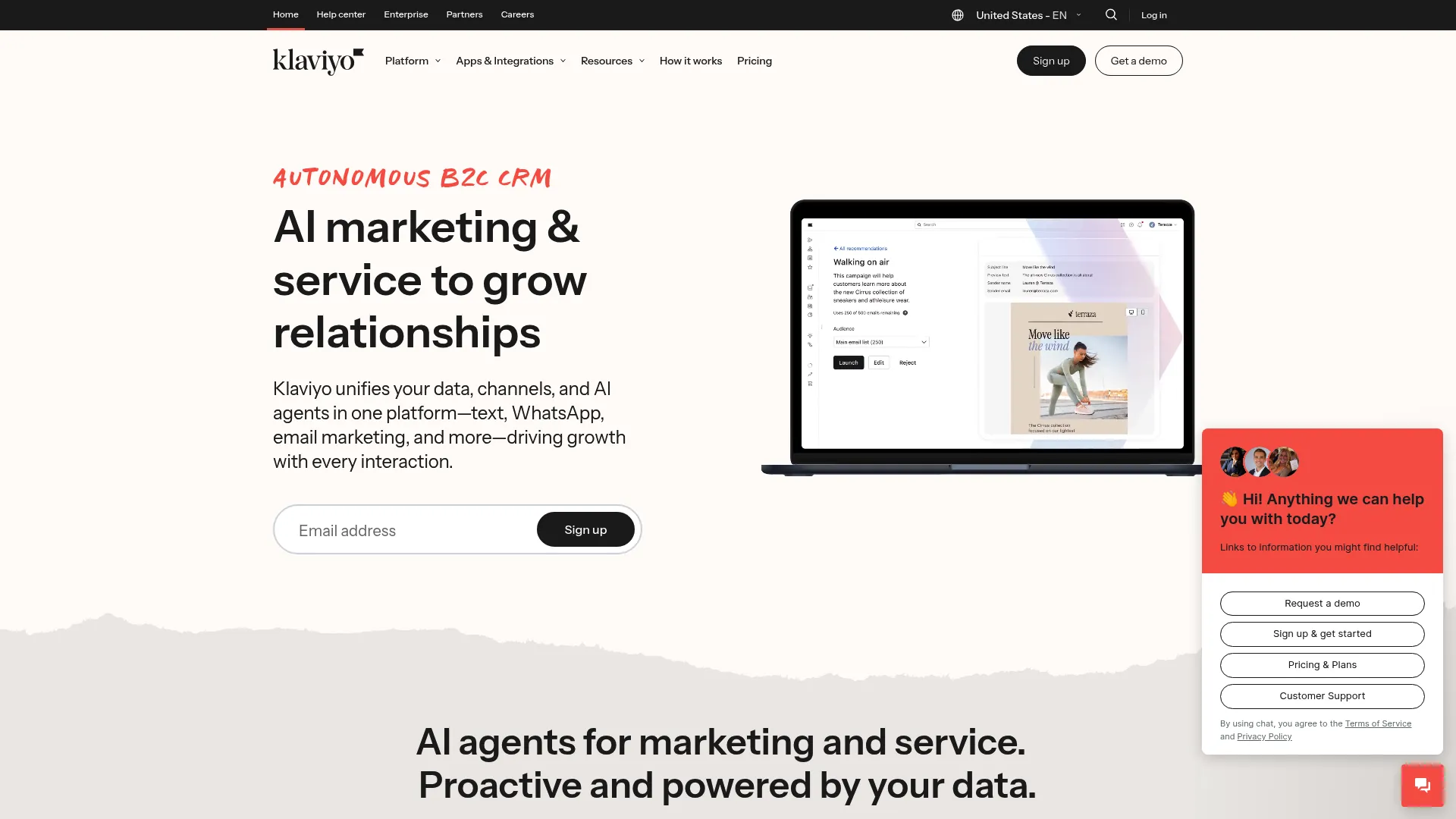
What You Get
Klaviyo specializes in ecommerce automation with pre-built workflows for abandoned carts, welcome series, and post-purchase follow-ups. The product recommendation engine suggests relevant items based on browsing and purchase history. Advanced segmentation uses purchase behavior and customer lifecycle stages.
SMS marketing integrates seamlessly with email campaigns for coordinated messaging. The platform includes review management systems and gamified signup forms like spin-to-win wheels.
What’s Great
The revenue attribution gives you clear ROI visibility – you can see exactly which emails make you money. Ecommerce integrations run deeper than competitors, syncing product catalogs, inventory levels, and customer data in real-time. The predictive analytics help identify high-value customers before they even make their first big purchase.
Segmentation capabilities are incredible – you can target people based on incredibly specific purchase behavior, engagement patterns, and predicted actions. Their support team actually understands ecommerce challenges instead of giving generic advice.
What’s Not So Great
Pricing gets expensive fast as your contact list grows – this is a real problem for businesses with large subscriber bases. The ecommerce focus makes it less useful for service-based businesses or B2B companies without product catalogs.
The interface can feel overwhelming if you’re used to simpler email platforms. You’ll need to invest serious time to use all the advanced features effectively. Some users report the platform slows down during high-traffic periods like Black Friday.
The Real Deal
Pricing escalates quickly – Higher cost but strong ROI for ecommerce stores
Features are ecommerce-focused – Unmatched specialized capabilities
Emails get delivered well – Strong inbox placement performance
Learning curve is steep – Powerful but requires time investment
Integrations run deep – Excellent ecommerce platform connections
What Users Actually Say
Ecommerce businesses rave about Klaviyo’s revenue impact and segmentation power. Users highlight the platform’s ability to identify high-value customers and optimize campaign timing for maximum sales.
The main complaint is pricing escalation as lists grow. Some users feel the platform’s complexity is overkill for businesses wanting simple email marketing rather than comprehensive ecommerce optimization.
Source: Klaviyo Product Reviews
Pricing
Klaviyo offers a free plan for up to 250 contacts with basic email and SMS features. Paid plans start at $20/month for 500 contacts, but costs scale significantly with list size.
Explore Klaviyo’s ecommerce features
MailerLite – Simple But Powerful
Email Marketing Without the Headache
MailerLite proves you don’t need overwhelming complexity to create effective email campaigns. While other platforms have grown bloated with features, MailerLite focuses on what most businesses actually need: beautiful email creation, reliable automation, and clear reporting.
The drag-and-drop editor feels intuitive from day one. You can create professional campaigns in minutes without design experience or technical knowledge. This simplicity extends throughout – every feature works exactly as expected without hidden complexity.
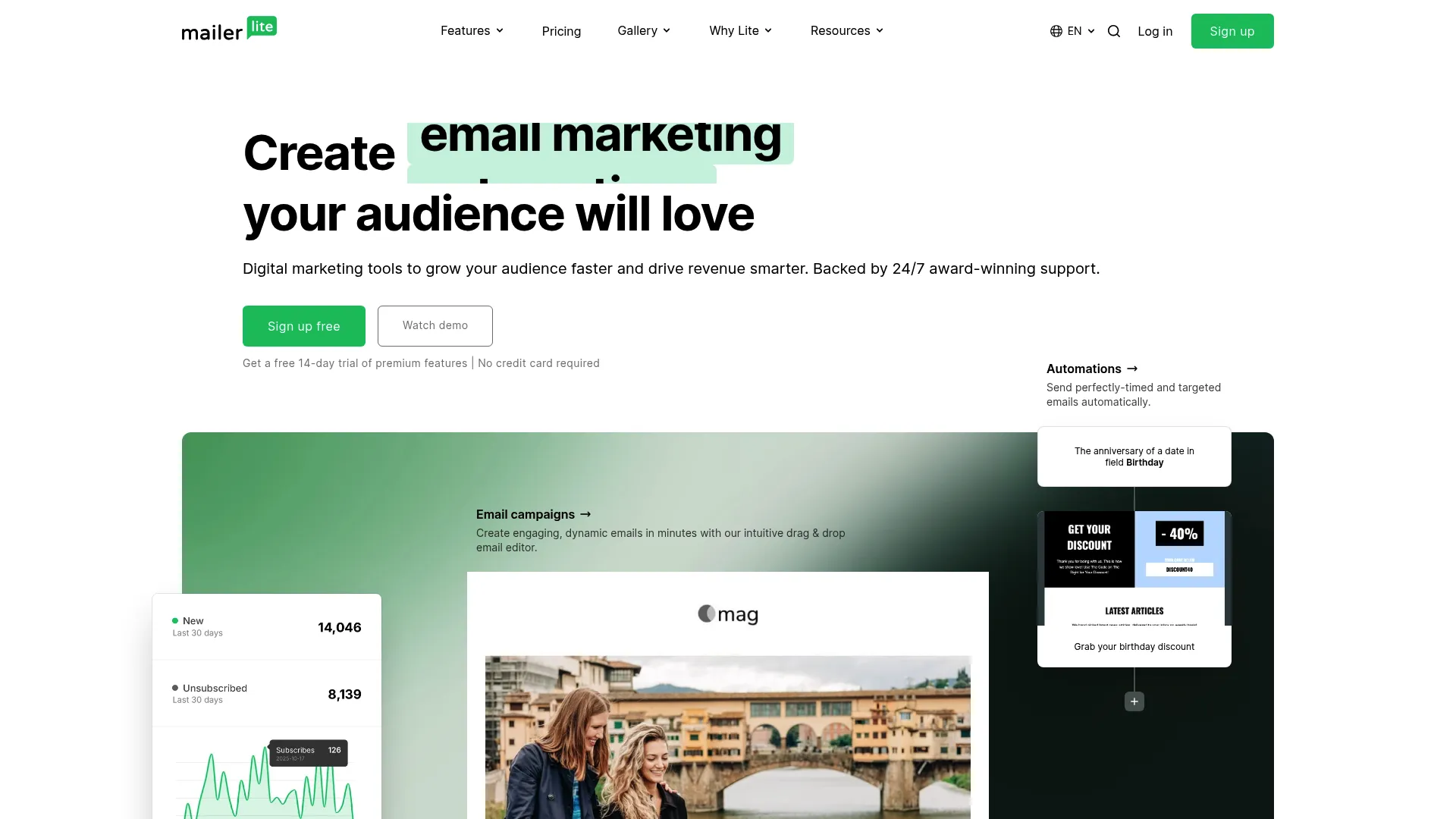
What You Get
MailerLite covers essential email marketing without bloat. The visual automation builder creates workflows with behavioral triggers and conditional logic. You also get landing page creation, form building, and even basic website creation.
Advanced segmentation allows precise audience targeting, and A/B testing helps optimize performance. The platform includes survey creation and digital product sales capabilities.
What’s Great
The interface genuinely feels effortless – new team members can create campaigns immediately without training. Pricing stays reasonable even as your list grows, with transparent costs and no surprise fees. The generous free plan includes most essential features.
Your emails actually reach inboxes (89.1% deliverability), and support responds quickly with helpful solutions. The focus on simplicity eliminates the feature overwhelm that plagues complex alternatives.
What’s Not So Great
Advanced automation capabilities lag behind specialized platforms. Reporting provides basic insights but lacks depth for sophisticated campaign optimization. Integration options are adequate but don’t match the extensive libraries of larger competitors.
Template selection feels limited, and some users eventually outgrow the platform’s capabilities as their email marketing gets more sophisticated.
The Real Deal
Pricing stays fair – Excellent value with generous free plan
Features cover the essentials – Solid core functionality without bloat
Deliverability is reliable – Consistently strong inbox placement
Super easy to use – Industry-leading simplicity
Integrations are adequate – Covers most popular tools
What Users Actually Say
Users consistently praise MailerLite’s simplicity and value. The platform gets frequent recommendations for small businesses and creators who need effective email marketing without complexity. Support quality earns regular mentions.
Some users note that advanced marketers may eventually outgrow the platform’s capabilities. However, most appreciate the straightforward approach that eliminates decision paralysis.
Source: EmailTooltester MailerLite Review
Pricing
MailerLite provides a free plan for up to 1,000 subscribers with 12,000 monthly emails. The Growing Business plan starts at $9/month for 500 contacts with unlimited emails and advanced features.
Constant Contact – Old School But Reliable
When You Need a Human to Answer the Phone
Constant Contact has been around since 1995, and honestly, it shows. The platform feels dated compared to sleeker alternatives, but there’s something to be said for their old-school approach to customer service and practical features.
What sets them apart is event management – you can create invitations, manage registrations, sell tickets, and handle check-ins all within the same system. This makes it particularly valuable for businesses that regularly host workshops, seminars, or community events.
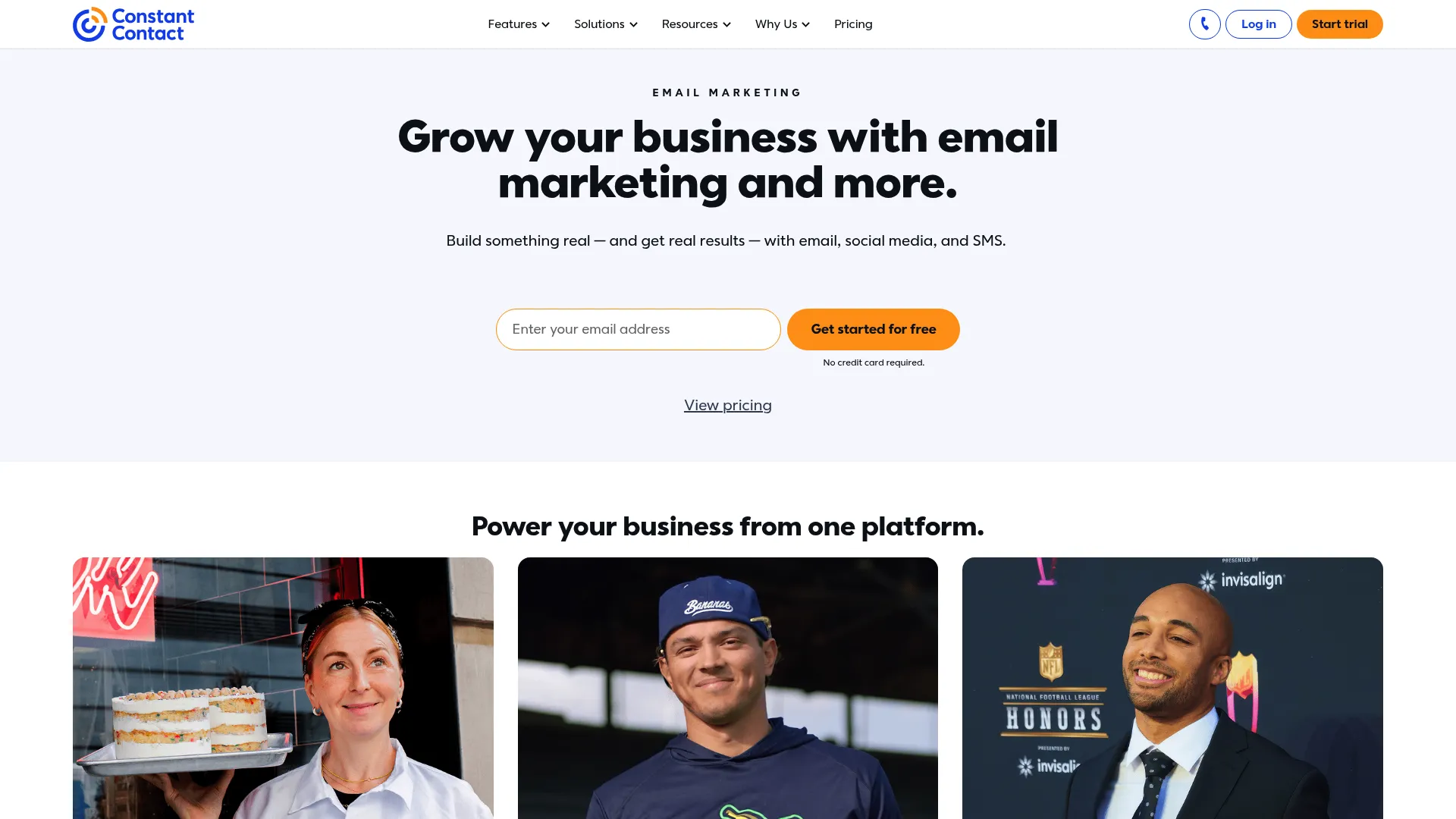
What You Get
Beyond email marketing, Constant Contact includes social media management, survey creation, and over 200 email templates. The event management tools handle everything from invitations to payment processing. AI-powered content generation helps create email copy and social posts.
Basic automation workflows are available, though they’re simpler than specialized competitors. Integration options cover popular small business tools.
What’s Great
Customer support actually picks up the phone with knowledgeable people who understand small business challenges. The extensive template library provides professional designs for virtually any industry. Event management eliminates the need for separate ticketing platforms.
Your emails get delivered reliably (91.7% success rate), and the platform’s stability has been proven over decades. If you need something that just works without surprises, this fits the bill.
What’s Not So Great
Pricing feels high for what you get – there’s no free plan, and features lag behind more affordable alternatives. The automation capabilities are pretty basic compared to modern platforms. The interface feels like it’s stuck in 2010.
Advanced features are missing entirely, which limits growth potential for businesses with sophisticated marketing needs.
The Real Deal
Pricing is reasonable but no free option – Fair pricing but lacks competitive free tier
Features work well for small business – Solid basic functionality with event management
Deliverability is dependable – Consistently strong performance
Easy for beginners – Straightforward for simple needs
Integrations cover the basics – Good small business tool connections
What Users Actually Say
Small business owners praise Constant Contact’s customer support and event management features. The platform gets recommendations for organizations that prioritize reliable service over cutting-edge features.
Users often note the pricing feels steep for the feature set provided. Many eventually migrate to more feature-rich alternatives as their marketing needs grow beyond basic campaigns.
Source: EmailTooltester Constant Contact Review
Pricing
Constant Contact starts at $12/month for 500 contacts with basic email marketing. The Standard plan ($35/month) adds automation and advanced reporting.
Start your Constant Contact trial
GetResponse – The Swiss Army Knife
Everything in One Place (For Better or Worse)
GetResponse tries to be your complete marketing toolkit – email marketing, webinar hosting, landing pages, and sales funnels all in one platform. The webinar integration is genuinely unique, letting you host live and automated webinars then automatically follow up with attendees and no-shows.
This all-in-one approach eliminates the need for multiple tools, but it also means GetResponse is pretty good at most things without being exceptional at any single function.
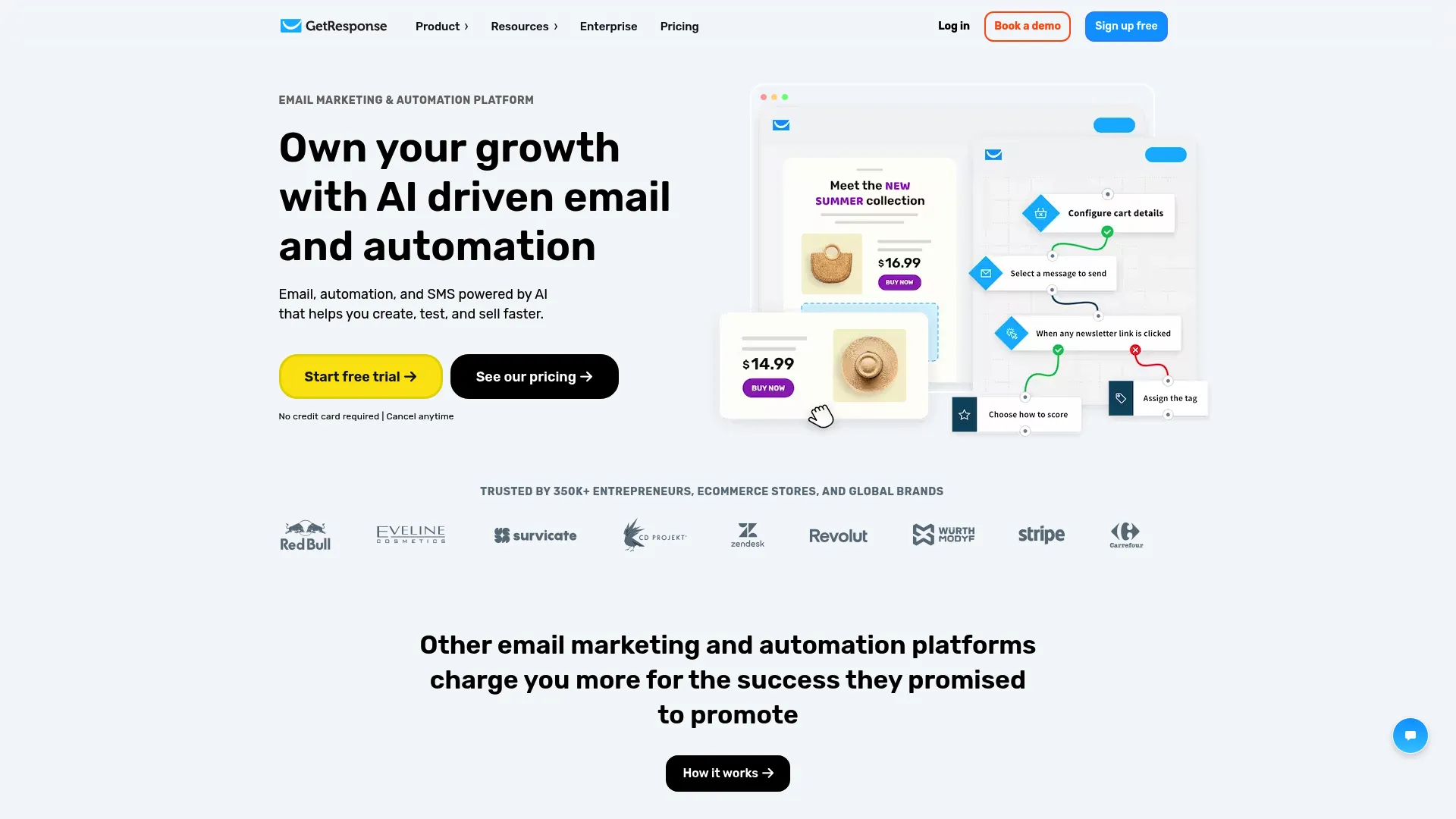
What You Get
GetResponse includes advanced automation with visual builders and behavioral triggers. The Conversion Funnel feature creates complete sales processes from landing pages through checkout. AI-powered tools optimize send times and generate email content.
Webinar hosting supports up to 1,000 attendees with screen sharing and interactive features. Ecommerce integrations provide abandoned cart recovery and product recommendations.
What’s Great
The webinar integration creates marketing opportunities you won’t find elsewhere. Conversion Funnels simplify complex sales process creation without needing separate tools. Your emails get delivered reliably (90.3% success rate).
Pricing stays competitive despite the extensive feature set. The visual automation builder makes complex workflows accessible to non-technical users.
What’s Not So Great
The interface feels cluttered because of all the features – it can be overwhelming for new users. Some features feel less polished than specialized alternatives since the platform tries to do everything.
Advanced features require higher-tier plans, making it expensive if you need comprehensive functionality. The learning curve is steep if you want to use all available capabilities.
The Real Deal
Pricing offers good value – Reasonable cost for comprehensive features
Features are extensive – Complete all-in-one capabilities
Deliverability is solid – Strong inbox placement rates
Interface can feel busy – Intuitive despite feature complexity
Integrations are solid – Good ecosystem coverage
What Users Actually Say
Users appreciate GetResponse’s comprehensive feature set and webinar capabilities. The platform gets praise for eliminating the need for multiple marketing tools while maintaining competitive pricing.
Some users note the extensive features can feel overwhelming initially. It works best for businesses that can leverage multiple capabilities rather than those seeking simple email marketing.
Source: EmailTooltester GetResponse Review
Pricing
GetResponse offers a free plan with basic features for up to 500 contacts. Paid plans start at $15/month for email marketing and automation. Higher tiers add webinar hosting and advanced features.
Explore GetResponse’s all-in-one platform
Omnisend – Built for Online Stores
Multi-Channel Done Right (Mostly)
Omnisend focuses exclusively on ecommerce, understanding that online stores need different tools than service providers. Their omnichannel approach coordinates email, SMS, and push notifications in unified campaigns – when someone abandons their cart, they might get an email immediately, an SMS after 2 hours, and a push notification the next day.
The platform includes gamified signup forms like spin-to-win wheels and scratch cards that actually help grow your email list instead of just annoying visitors.

What You Get
Omnisend specializes in ecommerce automation with pre-built workflows for abandoned carts, welcome series, and post-purchase follow-ups. Product recommendation engines suggest relevant items based on browsing and purchase history. Advanced segmentation uses purchase behavior and customer lifecycle stages.
SMS marketing integrates seamlessly with email campaigns, and revenue attribution tracking shows which campaigns drive actual sales.
What’s Great
Ecommerce-specific features eliminate the need to adapt generic email tools for online stores. Multi-channel automation creates sophisticated customer journeys that increase conversion rates. The platform integrates deeply with major ecommerce platforms like Shopify and WooCommerce.
Pricing stays reasonable for the specialized feature set, and pre-built automation templates help stores launch effective campaigns quickly.
What’s Not So Great
Deliverability rates at 78.5% are honestly pretty disappointing for an ecommerce-focused platform – your carefully crafted campaigns might end up in spam folders. The narrow ecommerce focus makes it useless for service businesses or B2B companies.
Advanced features require paid plans, limiting free tier capabilities. Some users report platform slowdowns during peak shopping seasons when you need reliability most.
The Real Deal
Pricing is fair for ecommerce – Reasonable specialized pricing
Features excel for online stores – Excellent ecommerce-specific capabilities
Deliverability disappoints – Below-average inbox placement rates
Easy for ecommerce users – Intuitive for online store owners
Integrations run deep – Excellent ecommerce platform connections
What Users Actually Say
Ecommerce businesses praise Omnisend’s specialized features and multi-channel capabilities. Users highlight the platform’s ability to create sophisticated automated workflows that drive measurable revenue increases.
The main concern is deliverability performance compared to premium alternatives. The platform’s narrow focus limits appeal to businesses outside ecommerce.
Source: EmailTooltester Omnisend Review
Pricing
Omnisend offers a free plan for up to 250 contacts with basic email and SMS features. The Standard plan starts at $16/month for 500 contacts with advanced automation.
Start with Omnisend’s ecommerce tools
Moosend – Fancy Features, Budget Price
Advanced Automation Without the Premium Price Tag
Moosend challenges the assumption that sophisticated email marketing requires premium pricing. You get advanced automation workflows, detailed analytics, and professional features at prices that undercut most competitors significantly.
Despite the low cost, Moosend doesn’t compromise on essential capabilities. The visual automation builder rivals more expensive alternatives, and deliverability consistently exceeds 90%. It’s cheap but still does what you need – pretty rare combo.
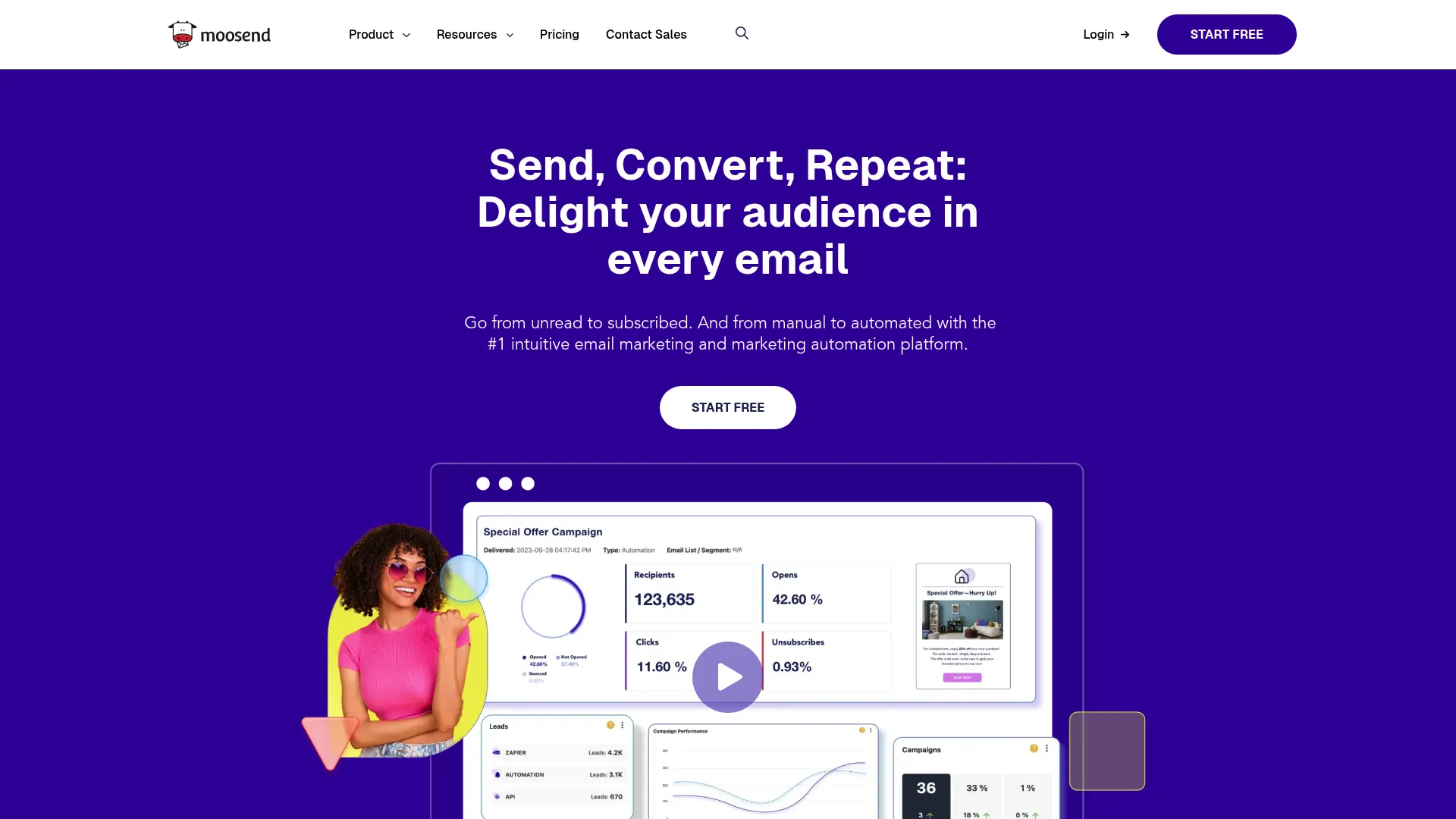
What You Get
Moosend includes advanced automation with behavioral triggers, conditional logic, and multi-step workflows. AI-powered product recommendations and audience discovery features come standard. Landing page creation, form building, and detailed reporting round out the package.
Website tracking enables behavior-based automation triggers – a feature typically reserved for premium platforms. Lead scoring helps identify high-value prospects automatically.
What’s Great
Pricing offers exceptional value with advanced features starting at just $7/month. The automation builder provides sophisticated workflow capabilities typically found in much more expensive platforms. Your emails actually reach inboxes (90.2% deliverability).
Support responds quickly with knowledgeable help, and unlimited emails on all plans eliminate sending restrictions. They even include unique features like weather-based automation triggers.
What’s Not So Great
The brand lacks recognition compared to established competitors, which might cause hesitation for enterprise buyers. Integration options feel limited compared to platforms with extensive third-party ecosystems. Template selection could be more extensive and modern.
Some interface elements feel less polished than premium alternatives. The focus on affordability sometimes comes at the expense of advanced features that sophisticated marketers eventually need.
The Real Deal
Pricing is exceptional – Amazing value for advanced features
Features are comprehensive – Solid automation capabilities
Deliverability is strong – Good inbox placement performance
Easy to figure out – Intuitive visual workflow builder
Integrations are limited – Adequate but not extensive options
What Users Actually Say
Users consistently praise Moosend’s value proposition and automation capabilities. The platform gets recommendations for budget-conscious businesses that need advanced features without premium pricing.
Some users note the limited brand recognition can make it harder to justify to stakeholders. However, most appreciate the significant cost savings without feature compromises.
Source: EmailTooltester Moosend Review
Pricing
Moosend starts at $7/month for 500 contacts with unlimited emails and advanced automation. The Pro plan ($15/month) adds premium features including landing pages and phone support.
Try Moosend’s affordable automation
HubSpot – Free CRM That Actually Works
The Platform That Does Everything
HubSpot approaches email marketing as part of a complete business growth platform rather than a standalone tool. The tight integration between marketing, sales, and service creates visibility into the entire customer lifecycle that you just can’t get elsewhere.
The free tier is genuinely impressive – unlimited users, 1,000 contacts, and comprehensive CRM functionality without cost. This makes HubSpot particularly attractive for startups that need multiple tools but lack budget for premium solutions.

What You Get
HubSpot’s Marketing Hub includes advanced automation, lead scoring, and behavioral tracking. The integrated CRM provides complete customer relationship management without additional cost. Sales tools, customer service features, and content management expand the platform’s reach.
AI-powered content creation helps generate email copy and social media posts. Advanced analytics provide detailed insights into campaign performance and ROI.
What’s Great
The free tier offers exceptional value with features that would cost hundreds monthly elsewhere. CRM integration eliminates data silos between marketing and sales teams. You won’t need to juggle five different apps.
Support provides excellent help with extensive documentation and training resources. The platform scales effectively from small businesses to enterprise organizations.
What’s Not So Great
Paid plans become extremely expensive quickly – Professional plans start at $890/month for advanced features. The platform’s complexity can overwhelm users seeking simple email marketing solutions. Email templates feel basic compared to design-focused alternatives.
Advanced automation features require expensive plans, making sophisticated workflows cost-prohibitive for smaller businesses. The interface gets cluttered due to the extensive feature set.
The Real Deal
Pricing is generous then expensive – Amazing free plan but costly paid tiers
Features are comprehensive – Complete all-in-one platform
Deliverability is good – Solid inbox placement performance
Complex due to scope – Overwhelming for simple needs
Integrations are extensive – Connects with everything
What Users Actually Say
Small businesses praise HubSpot’s free tier value and CRM integration capabilities. Users highlight the platform’s ability to provide enterprise-level features without initial cost, making it ideal for growing companies.
However, users frequently express sticker shock when exploring paid plans. It works best for businesses that can leverage multiple capabilities rather than those seeking simple email marketing.
Source: EmailTooltester HubSpot CRM Review
Pricing
HubSpot offers a generous free plan with CRM, basic email marketing, and landing pages. Marketing Hub starts at $15/month per seat for additional features. Professional plans ($890/month) include advanced automation and analytics.
Kit (formerly ConvertKit) – Made for Content Creators
Built for People Who Create Stuff
Kit understands that creators need more than just email marketing – they need tools to build sustainable businesses around their content. The platform combines traditional email marketing with monetization features that help creators generate revenue directly from their audiences.
The Creator Network feature is genuinely unique, allowing creators to recommend each other’s newsletters and build collaborative growth strategies. This community-driven approach reflects Kit’s deep understanding of how modern creators actually build and monetize their audiences.
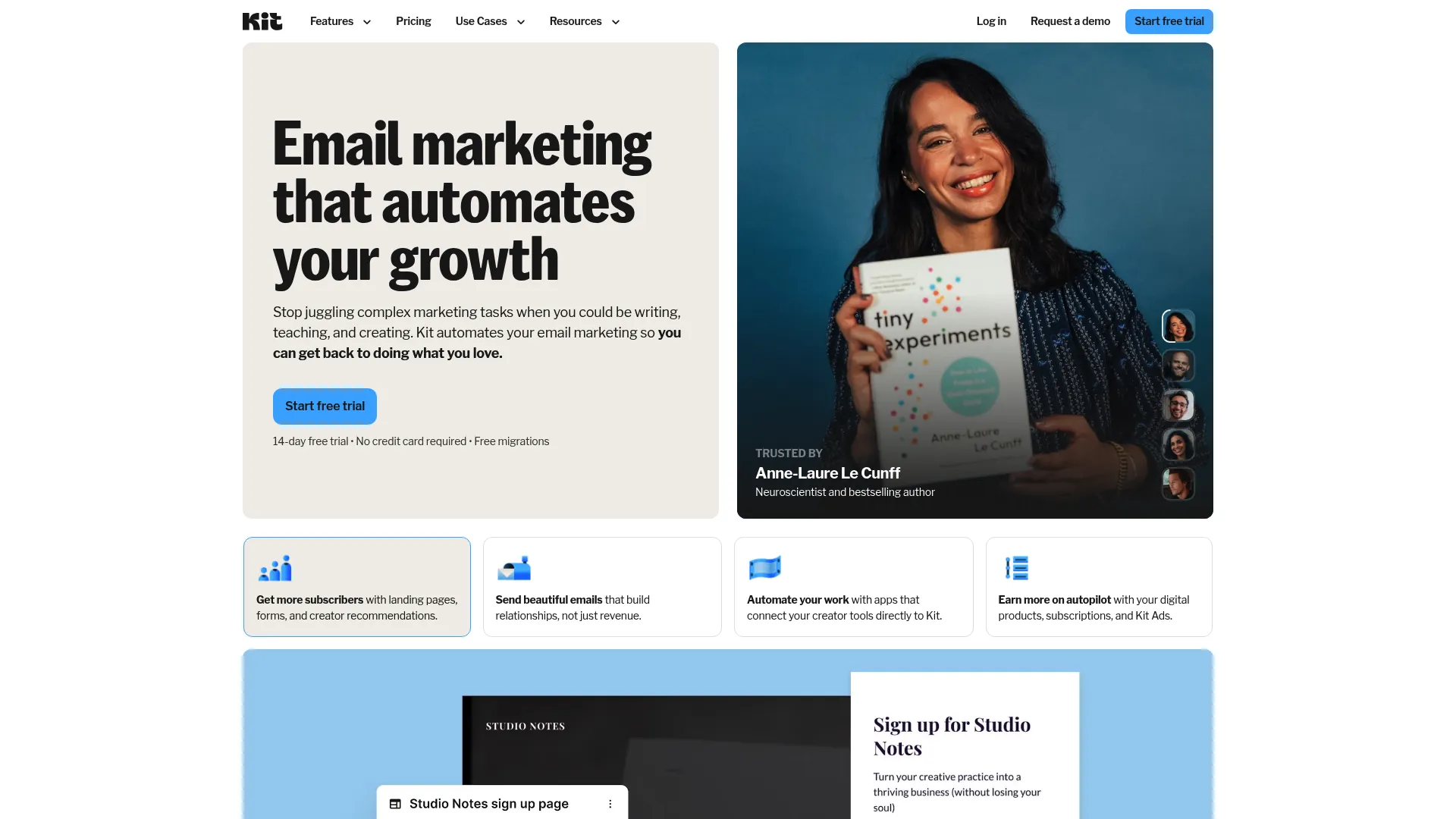
What You Get
Kit includes visual automation builders, advanced segmentation, and behavioral triggers for email sequences. The Commerce feature enables digital product sales directly through email campaigns. Paid subscription management handles recurring revenue streams automatically.
Landing page creation focuses on conversion optimization with templates designed specifically for creator needs. The Tip Jar feature allows audience members to support creators with one-time payments.
What’s Great
Monetization features provide multiple revenue streams beyond traditional advertising or affiliate marketing. The Creator Network offers unique growth opportunities through cross-promotion with other creators. Visual automation workflows make complex sequences accessible without technical expertise.
Support understands creator-specific challenges and provides relevant guidance. The platform’s focus on simplicity eliminates unnecessary complexity that can distract from content creation.
What’s Not So Great
Pricing escalates significantly as subscriber lists grow, making it expensive for creators with large audiences. Template selection feels limited compared to design-focused platforms. Advanced analytics capabilities lag behind data-rich alternatives.
The creator focus makes it less suitable for traditional businesses or B2B companies. Some automation features feel basic compared to specialized marketing platforms.
The Real Deal
Pricing is fair for creators – Good value for creator-specific features
Features excel for monetization – Excellent revenue capabilities
Deliverability is solid – Good inbox placement performance
Simple creator-focused interface – Easy for content creators
Integrations are adequate – Limited but covers creator needs
What Users Actually Say
Creators consistently praise Kit’s monetization features and community-building tools. The platform gets frequent recommendations from successful bloggers and podcasters who’ve built sustainable businesses using its features.
Some users express frustration with pricing increases as audiences grow. The narrow focus limits appeal for businesses outside the creator economy, though this specialization benefits its target audience.
Source: EmailTooltester Kit Review
Pricing
Kit offers a free Newsletter plan for up to 1,000 subscribers with basic features. The Creator plan starts at $25/month with advanced automation and monetization tools.
Notable Mentions
AWeber
AWeber provides reliable small business email marketing with excellent customer support and 600+ templates. While automation capabilities lag behind modern competitors, it offers solid basic functionality with phone support across all plans. If you need something dependable without bells and whistles, it’s worth considering.
Sender
Sender stands out with an extremely generous free plan (2,500 subscribers, 15,000 monthly emails) and exceptional 99.3% deliverability rates. Budget-conscious businesses appreciate the transparent pricing and instant customer support.
Campaign Monitor
Campaign Monitor excels in design-first email marketing with pixel-perfect templates and brand consistency tools. Agencies managing multiple client brands particularly value its polished design experience.
Mailjet
Mailjet specializes in transactional email and collaborative campaign creation with real-time team editing features. Strong GDPR compliance and budget-friendly high-volume pricing make it attractive for European businesses.
Frequently Asked Questions
What makes these alternatives better than Mailchimp?
These platforms address Mailchimp’s key problems: escalating pricing, limited automation capabilities, and basic reporting. Many alternatives offer better deliverability rates, more sophisticated segmentation, and pricing models that scale more reasonably with business growth. Advanced features like behavioral triggers, revenue attribution, and multi-channel campaigns often come standard rather than requiring expensive upgrades.
How do I migrate from Mailchimp without losing subscribers?
Most platforms offer free migration assistance, including contact imports, template recreation, and automation setup. Start by exporting your Mailchimp subscriber lists and campaign data. Many alternatives provide dedicated migration teams that handle the technical aspects while ensuring compliance with email regulations. Plan the transition during low-activity periods to minimize disruption.
Which platform has the best deliverability rates?
Sender leads with 99.3% deliverability, followed by ActiveCampaign at 94.2% and Constant Contact at 91.7%. However, deliverability depends heavily on your sending practices, list quality, and authentication setup. Focus on platforms that provide authentication guidance, list cleaning tools, and deliverability monitoring rather than just headline rates.
Are free plans actually worth using for business?
Several platforms offer genuinely useful free plans. HubSpot provides comprehensive CRM integration, MailerLite includes automation features, and Brevo offers unlimited contact storage. These work well for testing platforms or very small businesses, but most growing companies eventually need paid features for advanced functionality.
How important are integrations when choosing a platform?
Integrations become critical as your marketing stack grows. Native integrations typically work more reliably than third-party connections through Zapier. Consider your current tools (CRM, ecommerce platform, analytics) and future needs. Platforms like ActiveCampaign and HubSpot offer extensive integration libraries, while specialized tools excel at specific connections.
Understanding how different platforms integrate with your existing marketing strategy is crucial. For businesses looking to maximize their email marketing ROI, our email marketing case study demonstrates how strategic platform selection can drive measurable results.
Final Thoughts
Look, there’s no perfect email platform. But there are definitely better options than paying Mailchimp’s inflated prices for basic features.
My honest recommendations: – Just need simple newsletters? Go with MailerLite – Running an online store? Try Klaviyo (but watch those costs) – Want everything in one place? HubSpot’s free plan is har d to beat – On a tight budget? Moosend or Brevo won’t disappoint – Need advanced automation? ActiveCampaign is worth the investment – Creating content for a living? Kit understands your world
The best platform is the one you’ll actually use. Don’t get caught up in feature lists – pick something that fits your budget and skill level, then focus on writing emails people want to read.
We’ve all been there – your list hits 2,000 contacts and suddenly your bill doubles. Or you spend hours trying to set up a simple automation that should take minutes. These alternatives solve those problems while often costing less and delivering better results.
The email marketing landscape has evolved far beyond Mailchimp’s original vision. Modern businesses need platforms that understand their specific challenges, whether that’s ecommerce revenue optimization, creator monetization, or B2B lead nurturing.
Nonprofit organizations have unique requirements, and several alternatives offer specialized pricing and features. Platforms like Constant Contact provide dedicated nonprofit support, while options such as MailerLite offer generous free plans that accommodate tight budgets without compromising functionality.
However, selecting the right platform is just the beginning. The most sophisticated automation workflows and beautiful templates won’t drive results without strategic planning, compelling content, and continuous optimization based on performance data.
At The Marketing Agency, we’ve helped hundreds of businesses maximize their email marketing ROI across all these alternatives. Our email marketing services focus on extracting maximum conversion value from your existing audience while building sophisticated customer journey mapping that turns subscribers into loyal customers. Whether you’re implementing advanced automation workflows, developing comprehensive segmentation strategies, or creating high-converting campaigns that integrate seamlessly with your broader marketing efforts, our data-driven approach ensures your email marketing investment delivers measurable results.
For businesses requiring comprehensive digital marketing support, our marketing automation services help orchestrate multi-channel campaigns that work in harmony with your chosen email platform.
Still stuck? That’s what we’re here for. We’ll help you select the perfect alternative and build the strategic framework to maximize its potential for your specific business goals.





